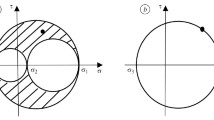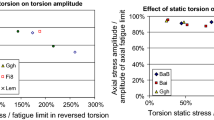Abstract
Several models have been proposed in the literature to account for fatigue damage under multiaxial load histories. Most of them require some measure of an equivalent stress or strain amplitude, in the sense of causing the same damage as the original history, which may be difficult to obtain for generic non-proportional multiaxial variable amplitude load histories. To identify individual load cycles, a multiaxial rainflow-like algorithm must be employed. For each rainflow-counted cycle, the equivalent stress or strain amplitude along its path is often computed using the so-called convex enclosure methods, which find minimum spheres, ellipsoids, or rectangular prisms that contain the load path in a deviatoric stress or strain space. However, such procedure involves information loss, in special if the path shape is very different from the shape of the enclosing convex surface, resulting in poor estimates of equivalent stress or strain amplitudes. To overcome this problem, the moment of inertia (MOI) method has been proposed in Meggiolaro and Castro (Int J Fatigue 42:217–226, 2012) to calculate equivalent amplitudes and mean components of two-dimensional stress or strain paths, generated, e.g., by tension–torsion or biaxial histories. In this work, the MOI method is extended to deal with generic 6D stress or strain paths, which include all normal and shear components. To accomplish that, the load history path is first represented in a 5D deviatoric stress or strain space and then assumed to be a homogeneous wire with unit mass, whose perimeter centroid is used to estimate the location of the path mean component. Then, the polar moment of inertia (PMOI) of such a hypothetical wire with respect to its mean component is calculated. The PMOI represents the distribution of the path about a single point, the perimeter centroid, giving a measure of how much the path stretches away from its mean component, which is used in the calculation of the equivalent amplitudes. Experimental results for 13 different multiaxial load histories prove the effectiveness of the proposed method to predict equivalent amplitudes and multiaxial fatigue lives.
Similar content being viewed by others
References
Meggiolaro M.A., Castro J.T.P.: An improved multiaxial rainflow algorithm for non-proportional stress or strain histories—part I: enclosing surface methods. Int. J. Fatigue 42, 217–226 (2012)
Socie D.F., Marquis G.B.: Multiaxial Fatigue. Society of Automotive Engineers, Inc., Warrendale (2000)
Freitas, M., Li, B., Santos, J.L.T.: A numerical approach for high-cycle fatigue life prediction with multiaxial loading. In: Multiaxial Fatigue and Deformation: Testing and Prediction, ASTM STP 1387, ASTM (2000)
Li B., Santos J.L.T., Freitas M.: A unified numerical approach for multiaxial fatigue limit evaluation. Mech. Struct. Mach. 28(1), 85–103 (2000)
Li B., Santos J.L.T., Freitas M.: A computerized procedure for long-life fatigue assessment under multiaxial loading. Fatigue Fract. Eng. Mater. Struct. 24, 165–177 (2001)
Gonçalves C.A., Araújo J.A., Mamiya E.N.: Multiaxial fatigue: a stress based criterion for hard metals. Int. J. Fatigue 27, 177–187 (2005)
Zouain N., Mamiya E.N., Comes F.: Using enclosing ellipsoids in multiaxial fatigue strength criteria. Eur. J. Mech. A Solids 25, 51–71 (2006)
Mamiya E.N., Araújo J.A., Castro F.C.: Prismatic hull: a new measure of shear stress amplitude in multiaxial high cycle fatigue. Int. J. Fatigue 31, 1144–1153 (2009)
Deperrois, A.: Sur le calcul des limites d’endurance des aciers. Ph.D. Thesis, Ecole Poly-technique, Paris (1991)
Ballard P., Dang Van K., Deperrois A., Papadopoulos I.V.: High cycle fatigue and a finite element analysis. Fatigue Fract. Eng. Mater. Struct. 18(3), 397–411 (1995)
Araújo J.A., Dantas A.P., Castro F.C., Mamiya E.N., Ferreira J.L.A.: On the characterization of the critical plane with a simple and fast alternative measure of the shear stress amplitude in multiaxial fatigue. Int. J. Fatigue 33(8), 1092–1100 (2011)
Castro F.C., Araújo J.A., Mamiya E.N., Zouain N.: Remarks on multiaxial fatigue limit criteria based on prismatic hulls and ellipsoids. Int. J. Fatigue 31(11), 1875–1881 (2009)
Kane T.R., Levinson D.A.: Dynamics, Theory and Applications. McGraw-Hill, New York (2005)
Bannantine, J.A.: A Variable Amplitude Multiaxial Fatigue Life Prediction Method. FCP Report n. 151, University of Illinois at Urbana-Champaign (1989)
Bannantine, J.A., Socie, D.F.: A variable amplitude multiaxial fatigue life prediction method. In: Fatigue Under Biaxial and Multiaxial Loading, vol. 10, pp. 35–51. ESIS (1991)
Sines, G.: Behavior of metals under complex static and alternating stresses. In: Metal Fatigue, pp. 145–169. McGraw-Hill (1959)
Crossland, B.: Effect of large hydrostatic pressures on the torsional fatigue strength of an alloy steel. In: International Conference on Fatigue of Metals, pp. 138–149. IMechE, London (1956)
Papadopoulos I.V.: A new criterion of fatigue strength for out-of-phase bending and torsion of hard metals. Int. J. Fatigue 16, 377–384 (1994)
Papuga J., Ruzicka M.: Two new multiaxial criteria for high cycle fatigue computation. Int. J. Fatigue 30, 58–66 (2008)
Novozhilov, V.V.: Theory of Elasticity (J. J. Sherrkon trans.), Jerusalem: Israel Program for Scientific Translation (1961)
Mandel J.: Cours de Mécanique des Milieux Continus, tomes I and II. Gauthier-Villars, Paris (1966)
Wang C.H., Brown M.W.: Life prediction techniques for variable amplitude multiaxial fatigue—part 1: theories. J. Eng. Mater. Technol. 118, 367–370 (1996)
Meggiolaro M.A., Castro J.T.P.: An improved multiaxial rainflow algorithm for non-proportional stress or strain histories—part II: the modified Wang–Brown method. Int. J. Fatigue 42, 194–206 (2012)
Itoh T., Sakane M., Ohnami M., Socie D.F.: Nonproportional low cycle fatigue criterion for type 304 stainless steel. ASME J. Eng. Mater. Technol. 117, 285–292 (1995)
Itoh T., Chen X., Nakagawa T., Sakane M.: A simple model for stable cyclic stress–strain relationship of type 304 stainless steel under nonproportional loading. J. Eng. Mater. Technol. 122, 1–9 (1995)
Smith R.N., Watson P., Topper T.H.: A stress–strain parameter for the fatigue of metals. J. Mater. 5(4), 767–778 (1970)
Meggiolaro M.A., Castro J.T.P.: Automation of the fatigue design under variable amplitude loading using the ViDa software. Int. J. Struct. Integr. 1, 1–6 (2010)
Meggiolaro M.A., Castro J.T.P.: Prediction of non-proportionality factors of multiaxial histories using the moment of inertia method. Int. J. Fatigue 61, 151–159 (2014)
Author information
Authors and Affiliations
Corresponding author
Rights and permissions
About this article
Cite this article
Meggiolaro, M.A., de Castro, J.T.P. & Wu, H. Generalization of the moment of inertia method to estimate equivalent amplitudes for simplifying the analysis of arbitrary non-proportional multiaxial stress or strain histories. Acta Mech 227, 3261–3273 (2016). https://doi.org/10.1007/s00707-015-1542-9
Received:
Revised:
Published:
Issue Date:
DOI: https://doi.org/10.1007/s00707-015-1542-9




